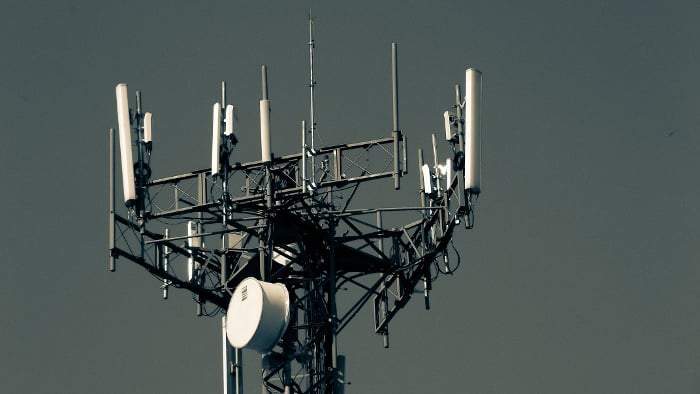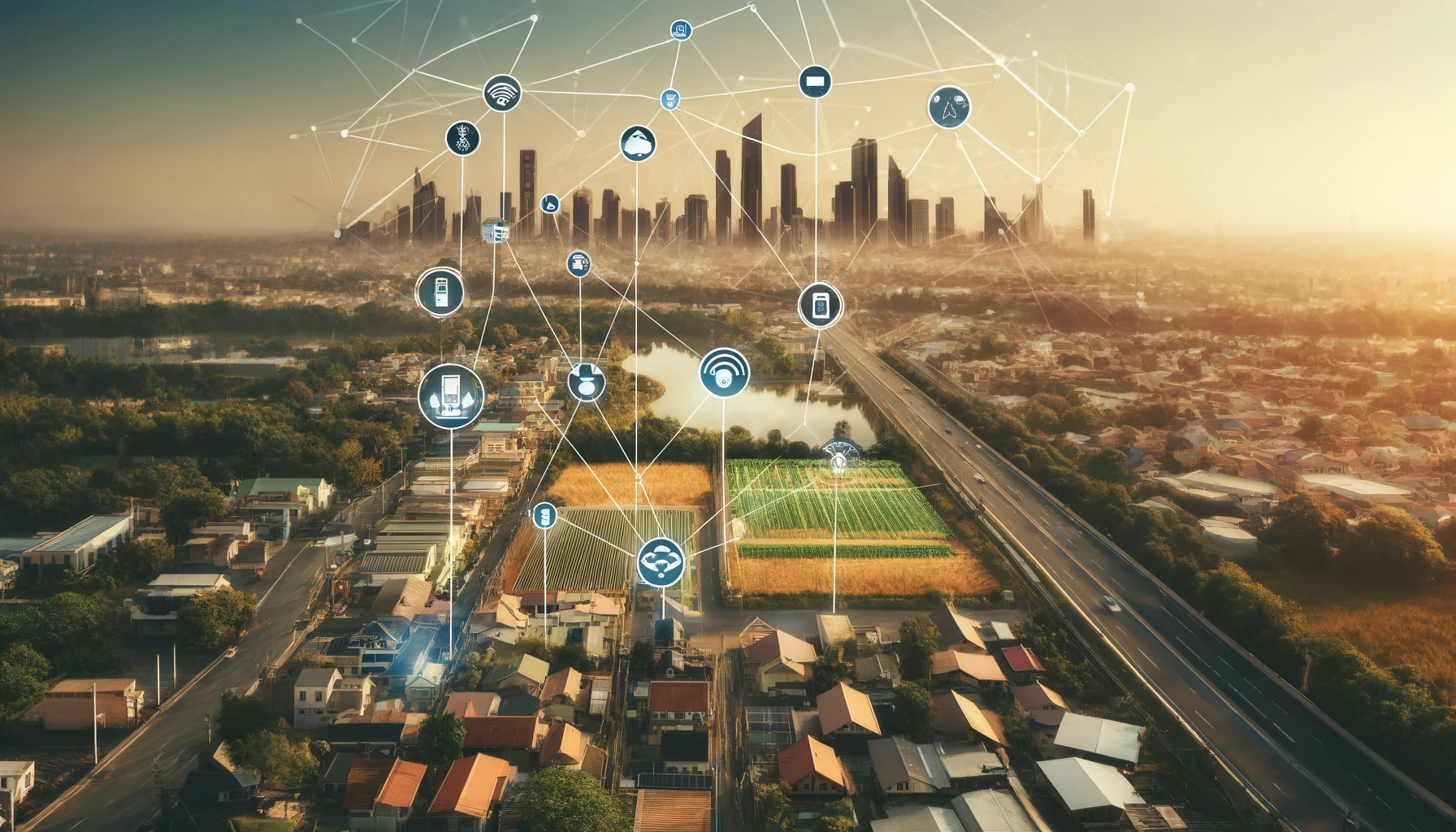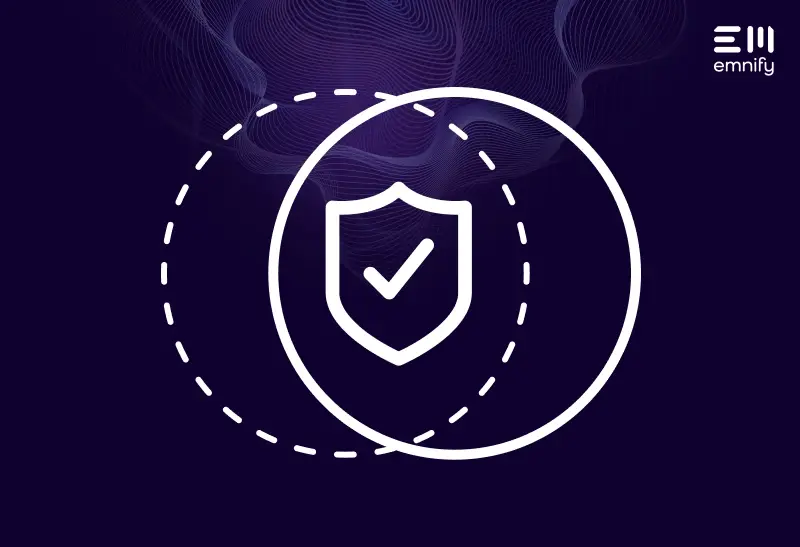

Quick definition: LPWAN stands for Low Power Wide Area Network. It’s a specialized category of wireless networks designed to maximize coverage, lower costs, and reduce power consumption for Internet of Things (IoT) devices. LPWANs is the fastest growing type of wireless network used in cellular IoT.
There are several kinds of LPWANs, but they all share some general characteristics, and they’re ideally suited for IoT applications. The type of LPWAN you choose determines the radio frequency (RF) bands, data rate, and cost structure your device uses.
LPWANs typically use a star topology, meaning the devices connect to a central access point (such as a cell tower) rather than directly to each other (like a Zigbee network, which uses a mesh topology).
We’re going to look at each of the main types of LPWANs you can use, but first, there are some essential concepts you should be familiar with as you explore the differences.
Licensed vs. unlicensed frequencies
Imagine a freeway with thousands of lanes encircling the globe. This is the electromagnetic spectrum, which we use for virtually all data transmissions. Every lane on this imaginary freeway is a specific radio frequency.
While there are many lanes, there are still a finite number of them, and some aren’t suitable to drive on. (Very high frequencies don’t travel far enough or penetrate objects enough to be useful for telecommunications.) Used efficiently, billions of devices around the world can share these lanes without any issues. But if too many cars (data transmissions) get in the same lane in the same place, it interferes with their ability to get from point A to point B.
You can also think about it like ripples in the water when you throw a rock into a pond. If everyone throws rocks into the same pond at the same time, the ripples will interfere with each other (they may even cancel each other out), and it becomes difficult to identify which ripple is coming from which rock.
To avoid too much traffic in a single lane or ripples in a single pond, a regulatory body like the Federal Communication Commission (FCC) may license particular entities (i.e. mobile network operators) to use a group of specific frequencies, sort of like a series of express lanes or private ponds. This is what it means when an LPWAN uses licensed radio frequencies. The devices on that particular network are the only ones legally allowed to use those frequencies.
Unlicensed frequencies are public, and therefore prone to more interference. But they’re also free, so you don’t pay for data usage. It’s a tradeoff. You can’t control who accesses an unlicensed frequency, so networks that use them are best suited for more remote applications.
Wifi networks, for example, all tend to use 2.4GHz or 5GHz bands. So if you’re using your Wifi and there are other networks nearby, they may interfere with your signal. LoRa and Wireless M-Bus networks both use 868 MHz, and they can interfere with each other as well. Lower frequency bands penetrate walls better and have better coverage, which means everyone wants to use them.
Some governments have attempted to combat overcrowding of frequency bands by regulating duty cycles. Often, they’ll only allow a device to use the frequency band 1% of the time. This prevents devices from constantly taking up bandwidth that everyone has to share.
Types of LPWANs
Now let’s look at some of the specific Low Power Wide Area Networks IoT manufacturers can choose from.
LoRaWAN
LoRaWAN stands for Long Range Wide Area Network. LoRaWANs are a type of LPWAN that doesn’t rely on cellular connectivity, and they use specific unlicensed frequency bands that vary from country to country.
LoRaWANs have some of the lowest (and narrowest) bandwidths of any LPWAN, but due to duty cycle regulations, devices connected via LoRaWANs can only send a limited number of messages per day.
While LoRaWANs are sometimes used in smart metering, alarm systems, and other common IoT applications, they’re most practical for remote scenarios where other networks don’t have great coverage and your devices are in one location.
This is because you don’t simply connect to an established LoRaWAN in the area you want to deploy, like you do with cellular networks. You set up the network in the area you intend to deploy.
Sigfox
Sigfox is a French company that creates LPWANs using proprietary technology. These networks are “ultra narrowband” (meaning they use very small frequency bands), and each country only has a single Sigfox network operator.
Sigfox networks claim to have a longer range than other proprietary LPWANs (up to 1,000 kilometers), but each day they can only send 140 messages of up to 14 bytes each and receive four messages of up to 8 bytes each. Sigfox gets used in everything from retail stores to industrial IoT to smart alarm systems. But its limited messaging capabilities inhibit regular firmware upgrades, so using Sigfox can create greater IoT security risks, and it’s simply not viable for applications that need to send a higher volume of messages per day.
Nb-IoT
Nb-IoT stands for Narrowband Internet of Things. It’s a specially adapted cellular network that can take advantage of unused (but licensed) bands in the radio frequency spectrum. Most carriers reserve a small frequency band from the LTE band, but NB-IoT also enables them to use a guard band (a band between two others) or other unused bands. Nb-IoT was designed to address some of the past challenges of using cellular connectivity in IoT devices, namely, its power consumption.
Cellular connected devices have to actively listen for a signal. They send periodic Tracking Area Updates (TAUs) to tell the network where they are. This results in greater power consumption when the device is in idle mode.
Nb-IoT gives devices the ability to use a Power Saving Mode (PSM) where they go to sleep when not in use. Additionally, they can use Discontinuous Reception (DRX) to extend the time between TAUs. This enables Nb-IoT devices to operate for years on a single battery charge.
Unlike LoRaWAN and Sigfox networks, Nb-IoT connectivity doesn’t require an investment in network infrastructure in the area you intend to deploy. NB-IoT networks use LTE towers and antennas. These cellular networks are already in place—you just have to connect to them. This allows manufacturers to create Internet-enabled devices that connect right out of the box.
In terms of range, coverage, and deployment cost, there’s no comparison. For mobile applications like asset tracking and supply chain logistics, cellular LPWANs are almost always the best choice.
4G LTE-M
4G is the fourth generation of cellular networks, and LTE-M is an abbreviation for long-term evolution machine type communication. Also known as Cat-M1 (Category M1), 4G LTE-M is an extension of 4G LTE technology that utilizes the same power-saving features (PSM and DRX) as NB-IoT. Also like NB-IoT, LTE-M networks rely on the same infrastructure as 4G LTE.
However, 4G LTE-M networks have a big advantage over Nb-IoT networks: they have far better data rates, which allows them to quickly transmit much larger data packages. This is crucial for firmware updates. And throughout the lifecycle of your device, you’ll be able to upgrade them to handle new use cases that require more data.
4G is also the most widely used cellular network, which means IoT devices can have good coverage nearly anywhere—especially if their SIM card has Multi-IMSI capabilities, which allows it to change carriers and select the network with the strongest signal.
Like Nb-Iot networks, LTE-M networks are ideal for long-range mobile applications like asset tracking, but they’re also well-suited for applications like law enforcement body cams, tracking teams of firefighters, and analytics-related devices. The more data you need to send or receive, the better LTE-M is in comparison to NB-IoT. It can transmit and download faster, which means your device stays online for less time.
Simple LPWAN connectivity
With emnify’s eSIMs, your device can connect to 4G LTE-M networks in more than 30 countries right out of the box. You don’t need to make a massive investment in connectivity infrastructure because the cellular networks are already in place. They’ll also be able to select the network with the strongest signal and roam between networks as needed.
Get in touch with our IoT experts
Discover how emnify can help you grow your business and talk to one of our IoT consultants today!
.jpg)
Jean-Eudes Ambroise
Director of Customer Success at emnify, Jean-Eudes is an expert in IoT.



